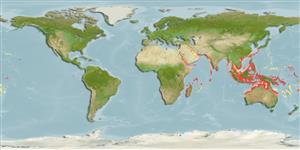>
Clupeiformes (Herrings) >
Dussumieriidae (Round herrings)
Etymology: Dussumieria: In honor of Dussumier, a collaborator of Cuvier, who sent him collections of fishes from the Indian Ocean (Ref. 45335).
More on author: Bleeker.
Environment: milieu / climate zone / depth range / distribution range
Écologie
marin; profondeur 0 - 50 m (Ref. 188). Subtropical; 31°N - 26°S, 32°E - 168°W (Ref. 188)
Indo-Pacific: Suez and western Indian Ocean (the Persian Gulf to Mombasa; possibly to Madagascar) to China, the Arafura Sea (Ref. 9819) and to about Tonga. Previous records of Dussumieria acuta from northeastern Indian Ocean would refer to this species (Ref. 5978).
Taille / Poids / Âge
Maturity: Lm ? range ? - ? cm
Max length : 20.0 cm SL mâle / non sexé; (Ref. 188)
Épines dorsales (Total): 0; Rayons mous dorsaux (Total): 16-18; Épines anales 0; Rayons mous anaux: 14 - 18. Branchiostegal rays more (13 to 17) and no striae on posterior part of scales; pelvic fins more advanced; W-shaped pelvic scute; isthmus with tapering evenly forward; more anal fin rays.
Pelagic inshore (Ref. 68964). The habitat and biology are presumably similar to those of D. acuta from which this species was not distinguished in earlier studies. Marketed fresh, may be dried or salted (Ref. 5284).
Life cycle and mating behavior
Maturité | Reproduction | Frai | Œufs | Fécondité | Larves
Whitehead, P.J.P., 1985. FAO Species Catalogue. Vol. 7. Clupeoid fishes of the world (suborder Clupeoidei). An annotated and illustrated catalogue of the herrings, sardines, pilchards, sprats, shads, anchovies and wolf-herrings. FAO Fish. Synop. 125(7/1):1-303. Rome: FAO. (Ref. 188)
Statut dans la liste rouge de l'IUCN (Ref. 130435)
Menace pour l'homme
Harmless
Utilisations par l'homme
Pêcheries: intérêt commercial mineur
Outils
Articles particuliers
Télécharger en XML
Sources Internet
Estimates based on models
Preferred temperature (Ref.
123201): 25.4 - 29.1, mean 28.3 °C (based on 1238 cells).
Phylogenetic diversity index (Ref.
82804): PD
50 = 0.7520 [Uniqueness, from 0.5 = low to 2.0 = high].
Bayesian length-weight: a=0.00776 (0.00485 - 0.01241), b=3.08 (2.94 - 3.22), in cm total length, based on LWR estimates for this species & (Sub)family-body (Ref.
93245).
Niveau trophique (Ref.
69278): 3.5 ±0.43 se; based on food items.
Generation time: 2.0 ( na - na) years. Estimated as median ln(3)/K based on 1
growth studies.
Résilience (Ref.
120179): Haut, temps minimum de doublement de population inférieur à 15 mois (K=0.55).
Fishing Vulnerability (Ref.
59153): Low vulnerability (24 of 100).
Climate Vulnerability (Ref.
125649): Moderate to high vulnerability (49 of 100).
Nutrients (Ref.
124155): Calcium = 174 [105, 347] mg/100g; Iron = 1.12 [0.61, 2.05] mg/100g; Protein = 20.8 [19.4, 22.1] %; Omega3 = 0.315 [0.164, 0.594] g/100g; Selenium = 77 [34, 157] μg/100g; VitaminA = 10.1 [3.9, 28.6] μg/100g; Zinc = 1.49 [1.04, 2.05] mg/100g (wet weight); based on
nutrient studies.
